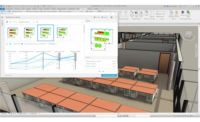Steel Revit Structure Model Transfers Show Great Promise








The next preferred method of transfer to SDS/2 is via the CIS/2 file. The next preferred method of transfer to Tekla is via the IFC file, said Cobb.
Transfer of information is not as simple as pushing a button, Cobb added. Sending and receiving parties each need to be educated on what is being sent, how it is prepared, to which software it is being sent and the purpose of the transfer.
Different transfers have different purposes. A transfer from Revit to a detailing software for visualization might require a different file type than a transfer for model information and for detailing, for example. IFC files are graphical re-creations of the 3D model from Revit. Members in an IFC file are not connected point to point and therefore will have a shorter length per member and an expected lower tonnage, explained Cobb.
The test also looked at the transfer relative to the steel-IDM data-exchange requirements. These include shapes, geometry, reference and cardinal points, ASTM designations, globally unique identifications (GUID), ownership and tracking information, and grid systems.
Shapes, geometry, and reference and cardinal points all transferred correctly between the software packages, with one exception, said Cobb: Braces in the Tekla CIS/2 file were not in the right place. The CIS/2 files also had a problem transferring pipe from Revit due to an incorrect naming convention. Grids were not transferred at all in any test case, he added.
SDLLC also looked at optional data transfers. Ownership and tracking information is available in most of the transfers, but is used only in the proprietary links. Non-structural parts are transferred and represented via the IFC links. Connections can be transferred visually via IFC links and with information via the SDS/2 Connect proprietary link. Other optional information is best transferred via the proprietary links.
Test details will be made available, but AISC has not yet decided on the format. Beyond that, Cobb said the next big step is to test a more difficult model—with sloping and curved members, joists, trusses, girts, sag rods and more.
| Yes | No | Yes | No | Yes | No | |
| Source: Structural Detailing LLc. Notes: *Revit issue with pipe, **Reference only, IFC=industry-foundation-class exchanges |







